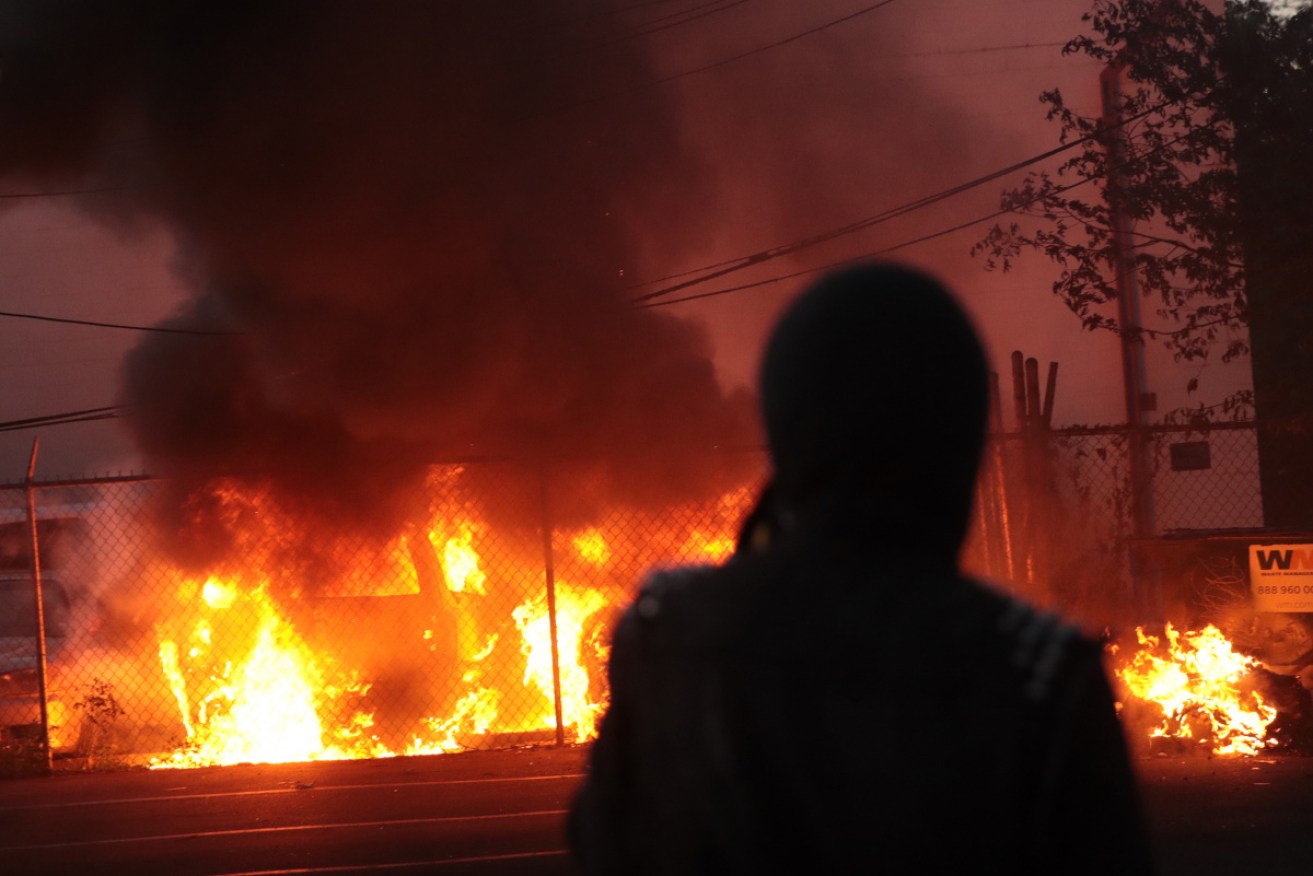US officer on murder charge over death of George Floyd as protests rage into the night


Vehicles burn during a protest sparked by the death of George Floyd while he was in police custody. Photo: Getty
A white Minneapolis police officer who pinned an unarmed black man with a knee to the neck before the man died has been arrested and charged with murder after three nights of violent protests in the Midwestern US city.
Authorities have imposed overnight curfews to try to stem violent protests over police killings of African Americans that have spread from Minneapolis and other US cities.
Protesters smashed windows at CNN headquarters in Atlanta, set a police car on fire and struck officers with bottles. Large protests in New York, Houston and other cities were largely peaceful – even in Minneapolis, where thousands marched downtown as the city’s 8 pm curfew ticked past and encircled a police precinct station.
“Prosecute the police!” some chanted, and “Say his name: George Floyd!” There was no violence, but some protesters sprayed graffiti on nearby buildings. Elsewhere in the city, forces fired tear gas and rubber bullets to drive back crowds of protesters.
It wasn’t clear if – or how – authorities would enforce the curfew, amid sharp questions about city and state leaders mishandling the crisis. The curfew came one night after protesters burned a police precinct station, and barriers were erected around at least two police precincts before nightfall.
The anger continued after US President Donald Trump yesterday added fuel to racial fires as he threatened to take action to bring the city of Minneapolis “under control”, calling violent protesters outraged by the death of a black man in police custody “thugs” and reviving a civil-rights era phrase fraught with racial overtones.
“When the looting starts, the shooting starts,” Mr Trump wrote in a tweet that was flagged by Twitter as violating rules against “glorifying violence”.
The White House said the President “did not glorify violence. He clearly condemned it”.
….These THUGS are dishonoring the memory of George Floyd, and I won’t let that happen. Just spoke to Governor Tim Walz and told him that the Military is with him all the way. Any difficulty and we will assume control but, when the looting starts, the shooting starts. Thank you!
— Donald J. Trump (@realDonaldTrump) May 29, 2020
Derek Chauvin, 44, was charged with third-degree murder and second-degree manslaughter. He also was accused of ignoring another officer who expressed concerns about Floyd as he lay handcuffed on the ground, pleading that he could not breathe as Chauvin pressed his knee into his neck. Floyd, who was black, had been arrested on suspicion of using a counterfeit bill at a store.
Chauvin, who was fired along with three other officers who were at the scene, faces more than 12 years in prison if convicted of murder.
A lawyer for Mr Floyd’s family welcomed the arrest but said he expected a more serious murder charge and wants the other officers arrested.
Prosecutor Mike Freeman said more charges were possible, but authorities “felt it appropriate to focus on the most dangerous perpetrator.”
Meanwhile, Minneapolis Mayor Jacob Frey declared a curfew from 8 pm to 6 am Friday and Saturday, with exceptions for emergency responders, the homeless and those seeking medical care.
“I know that whatever hope you feel today is tempered with scepticism and a righteous outrage,” Mr Frey said in a statement.
“Today’s decision from the County Attorney is an essential first step on a longer road toward justice and healing our city.”
Protests also spread across the US, fuelled by outrage over Mr Floyd’s death and years of police violence against African Americans. Demonstrators clashed with officers in New York and blocked traffic in Houston and San Jose, California. In Atlanta, demonstrators jumped on police cruisers, set one police car ablaze and broke windows at CNN’s headquarters, where hundreds were confronting police.
.@CNNValencia and crew take cover after an explosion takes place in the space between protesters and police at the CNN Center in Atlanta. https://t.co/mHZFrcOZj7 pic.twitter.com/HLPzyoKgn9
— CNN (@CNN) May 30, 2020
On Monday, police were trying to put Mr Floyd in a squad car when he stiffened and fell to the ground, saying he was claustrophobic, a criminal complaint said. Chauvin and Officer Tou Thoa arrived and tried several times to get the struggling Floyd into the car.
At one point, Chauvin pulled Mr Floyd out of the car’s passenger side, and Floyd, who was handcuffed, went to the ground face down. Officer JK Kueng held Mr Floyd’s back and Officer Thomas Lane held his legs while Chauvin put his knee on Floyd’s head and neck area, the complaint said.
When Mr Lane asked if Mr Floyd should be rolled onto his side, Chauvin said, “No, staying put is where we got him.” Lane said he was “worried about excited delirium or whatever.”
An autopsy said the combined effects of being restrained, potential intoxicants in Floyd’s system and his underlying health issues, including heart disease, likely contributed to his death. It revealed nothing to support strangulation as the cause of death.
There were no other details about intoxicants, and toxicology results can take weeks. In the 911 call that drew police, the caller describes the man suspected of paying with counterfeit money as “awfully drunk and he’s not in control of himself.”
After Mr Floyd apparently stopped breathing, Lane again said he wanted to roll Floyd onto his side. Mr Kueng checked for a pulse and said he could not find one, according to the complaint.
In all, Chauvin had his knee on Mr Floyd’s neck for 8 minutes, 46 seconds, including nearly three minutes after Mr Floyd stopped moving and talking, the complaint said.
-with agencies








